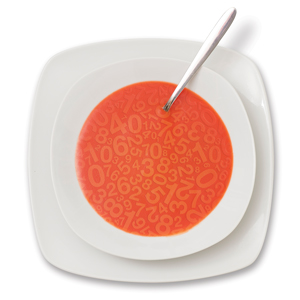Having taught math to over six hundred area elementary school students, I am a firm believer that children need to learn math concepts – not just math procedures. Let’s take cooking as an analogy. Right before my husband and I celebrated our thirtieth wedding anniversary, I was cooking a family favorite. When I pulled out the tattered and worn recipe book, I realized that over thirty years, I’ve probably made this recipe at least four hundred times. Yet, I dutifully follow the recipe step by step, the way that most children are taught to do math, by following the procedures in order – never straying from the recipe for mathematical success.
By comparison, my oldest daughter, Katie, has learned how one ingredient blends with another, how to go beyond the procedure to make numerous delicious dishes without a recipe or instructions. On a recent family camping trip, she took an assortment of leftovers and vegetables and made a delicious stir-fry flavored with random ingredients. This is how we need to teach children math. We need to help them understand how math works, how it is more than just a recipe to be followed, so that like my daughter does with her cooking, kids can blend math together to create something amazing.
When it comes to experiencing math, children need to fully understand math concepts. Here’s why:
1. To understand procedures.
To many children, math is just numbers on a page without any connections to what the numbers actually represent. Very few students are given the opportunity to touch math through the use of a variety of math manipulatives. When we let children explore numbers both physically and in written form, they begin to make connections between the two. By using counters to represent both positive and negative numbers, a child can quickly understand why subtracting a negative actually increases the end result.
2. To allow for flexible thinking about math.
Once a child understands the concepts behind the procedures, they begin to
think of math in flexible ways. Addition and subtraction are really the same operation. For example, instead of thinking that 13 – 7 = 6 and memorizing that specific math fact, we should teach them to add up from seven to ten (three) then to thirteen (three more) and the total is six. Along with this flexibility comes the ability to break away from the recipe or rigid procedure that they have been taught.
3. To increase enjoyment of math.
By understanding the concepts behind the procedures, math becomes more of a puzzle to be solved, not just a math sheet to be endured. Particularly when real life situations are used, math becomes fun – something that can be used every day in every situation, and not just in math class. One of the most rewarding aspects of teaching is when former students write or stop by to tell me how much they enjoy math after approaching it from a conceptual basis in their daily lives, and how much more successful they’ve become.
4. To increase confidence in math.
When students understand concepts, they are more willing to tackle challenging problems, even beyond their current math ability. While taking a standardized test this past year, a student was so confident in his ability to solve problems with exponents, he attempted a problem similar to one found on graduate school admissions exams. By going beyond the procedure or recipe, a child can turn to his or her conceptual understanding and not be afraid to experiment with new flavors or variations of the same ingredient.
5. To enhance performance.
All of these reasons combine to result in an increase in math performance. While we do live in a test- and grade-oriented educational system, the ultimate goal is success. Changes to the math SOL test and the future changes to the math section of the SAT necessitate an increased understanding of math for success. A simple solution is no longer acceptable, as students must now solve multi-step word problems. These changes make it imperative that children learn to think of math in flexible ways. With increased understanding, confidence, and enjoyment, success in math is the ultimate result.
6. To build a firm foundation for future success.
Just like building a house on a firm foundation, future success in mathematics depends upon a firm foundation on which to build more advanced concepts. To use a math analogy: Without understanding the relationship between a numerator and denominator in fractions, a thorough understanding of ratios and proportions will always be limited. Before I became a teacher, I knew that my oldest daughter really didn’t understand fractions. But what did I know, I was “just a mom.” Many moons later, when I had been teaching math conceptually for several years, she finally admitted to me that not understanding proportions had “hurt her during her entire math career.” Future math understanding and success is a direct result of current understanding and success. Without a firm foundation, the house eventually comes tumbling down. In my experience, this most often happens when a child reaches algebra, which is also when math grades become a determinate of future math and higher education paths.
In my years of teaching math, and watching my three daughters grow and develop throughout their math experiences, I’ve seen many different levels of math understanding, and many, many children who want math to make sense to them. In other words they want to understand how to make delicious math experiences without following the recipe that we’ve laid out before them. While it’s never too late to learn math conceptually, the earlier we can change how a child thinks about math, the better. While I may still be a hopeless recipe follower when it comes to actual cooking, I want children everywhere to stop following math recipes and strive to become accomplished chefs.




